Japanese incense is more than just a pleasant aroma—it’s a quiet, centuries-old practice rooted in mindfulness, nature, and everyday life.
Whether you discovered it during a visit to Japan, heard about its use in meditation, or simply want to add a calming ritual to your routine, this guide will show you everything you need to know.
From traditional ingredients like sandalwood and aloeswood, to the different forms of incense (sticks, cones, coils), to tips on how to use it at home—this article is your starting point.
You don’t need to be an expert. You don’t need to be spiritual.
All you need is curiosity—and maybe one good stick.
1. What Is Japanese Incense?
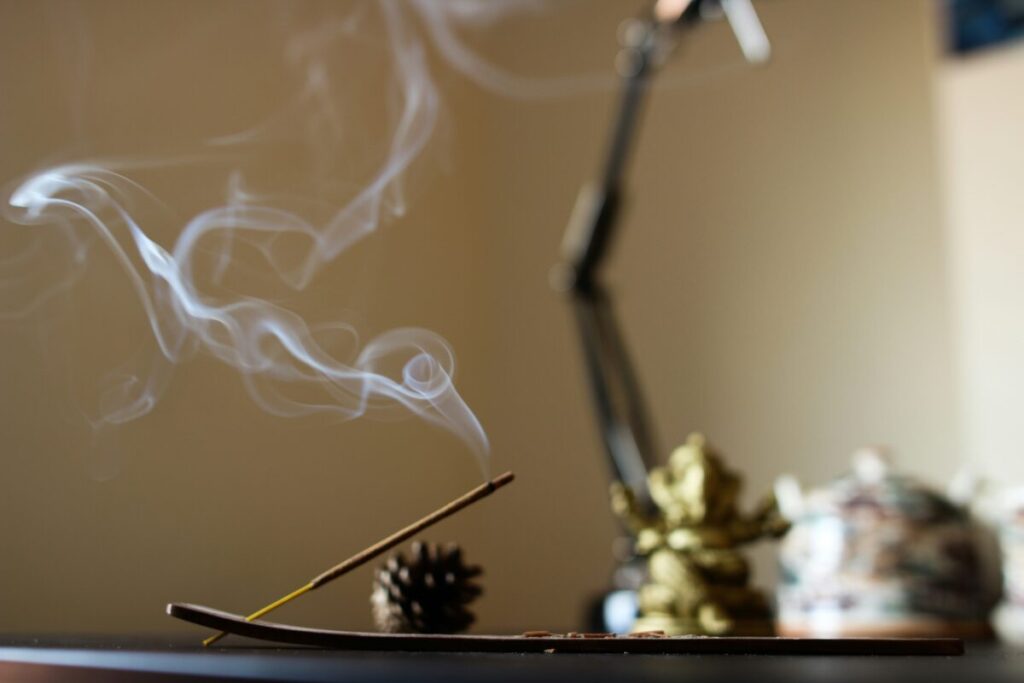
Japanese incense, called “kō” (香) in Japanese, is more than just something that smells nice.
It’s a quiet part of everyday life in Japan—used for relaxation, meditation, hospitality, and even spiritual rituals.
But unlike some other types of incense that produce heavy smoke or bold scents, Japanese incense is subtle, calming, and deeply connected to nature and tradition.
A Short History of Incense in Japan
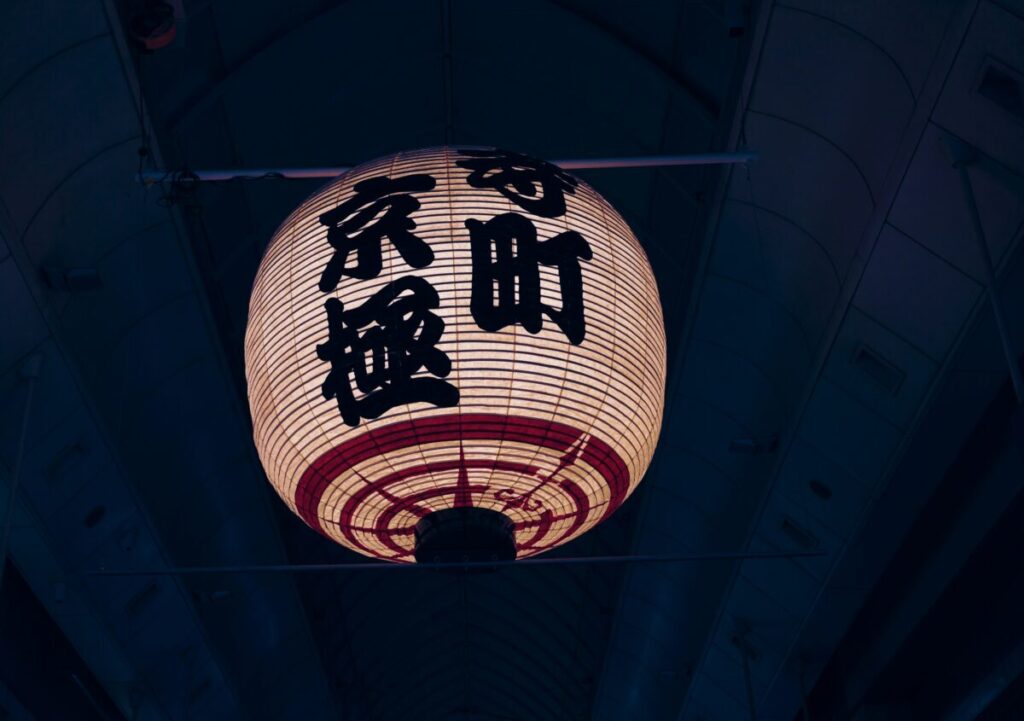
Incense first came to Japan over 1,400 years ago, carried by Buddhist monks from China and India. It was originally used in temples to purify spaces and accompany prayers.
During the Heian period (794–1185), incense became popular at the imperial court. Nobles created their own signature scents, and burning incense became a form of elegant entertainment.
Later, in the Edo period, incense culture spread to the common people. Samurai used it to prepare for battle. Merchants burned it at home and in shops to create a sense of calm. And Buddhist families burned it to honor their ancestors.
Today, incense is still used in temples—but also in homes, tea ceremonies, and even modern apartments. It’s a bridge between past and present, spirit and space.
What Makes Japanese Incense Unique?
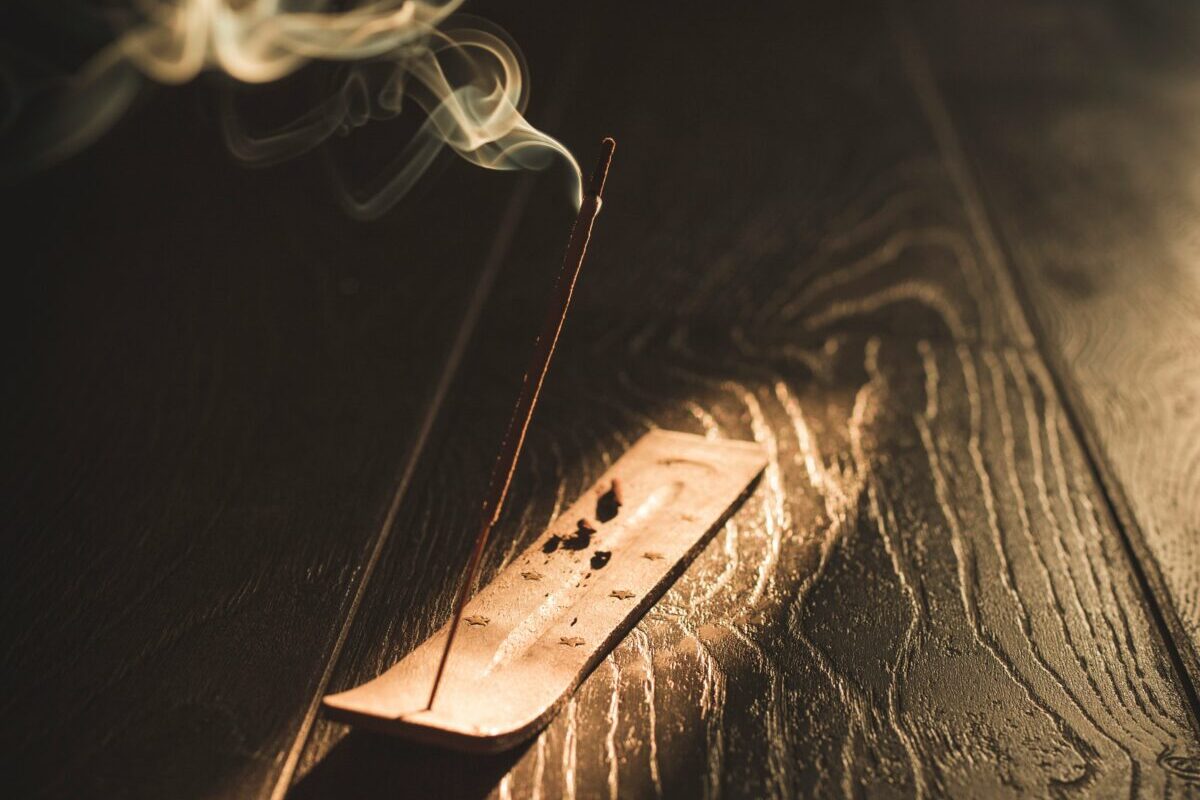
Japanese incense stands out for three main reasons:
- No bamboo stick inside
Most Japanese incense sticks are made purely from incense material—no wooden core—so they burn cleanly and evenly. - Subtle, layered fragrances
Rather than overpowering scents, Japanese incense is made from natural materials like sandalwood, aloeswood (jinkō), cinnamon bark, clove, and resins. The aroma is soft, earthy, and designed to blend into your environment. - Used for everyday moments
While incense in some cultures is mainly for rituals or ceremonies, Japanese incense is also used just to mark a moment—like opening the day, focusing before study, or relaxing before sleep.
 flo
floWhen I light incense, I’m not trying to make the whole room smell strong. I’m just trying to slow things down. That’s the heart of Japanese incense—it’s quiet on purpose.
Not Just for Religion
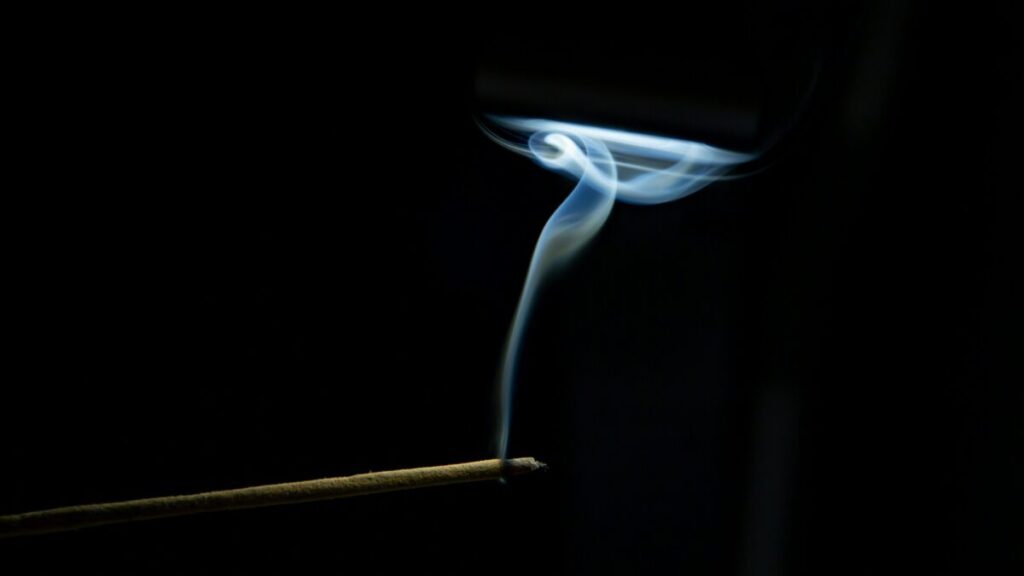

Many people think incense is only for spiritual or religious use.
But in Japan, incense is also
- creating a peaceful home atmosphere
- showing care to guests
- enhancing tea ceremonies
- scenting clothing or letters (especially in traditional culture)
- personal enjoyment—just because it feels good
So whether you’re religious or not, Japanese incense can simply be a tool for living more mindfully.
2. Types of Japanese Incense
Stick, Cone, Coil… What’s the Difference?
There are many ways to enjoy Japanese incense, and the type you choose depends on your space, your routine, and your personal taste. Here are the most common types, explained simply:
① Stick Incense (線香 – Senkō)
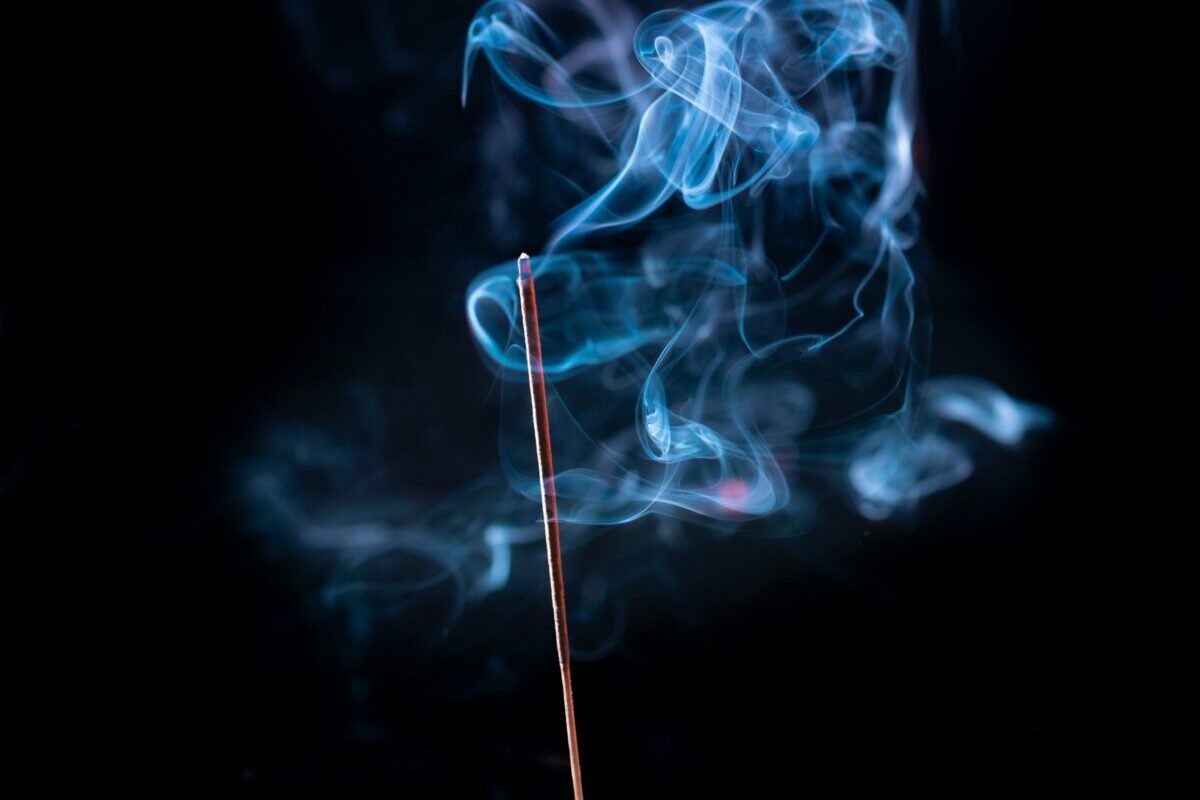

This is the most popular and widely used type of incense in Japan.
The sticks are made entirely from incense material—no bamboo inside—so they burn evenly and produce less smoke.
| Feature | Detail |
|---|---|
| Shape | Thin stick, 7–14 cm long |
| Burn time | 15–30 minutes |
| Fragrance | Subtle, clean, natural |
| Use | Daily relaxation, meditation, morning rituals |



This is what I use every day—one stick, one moment of quiet. It’s the easiest place to start.
② Cone Incense
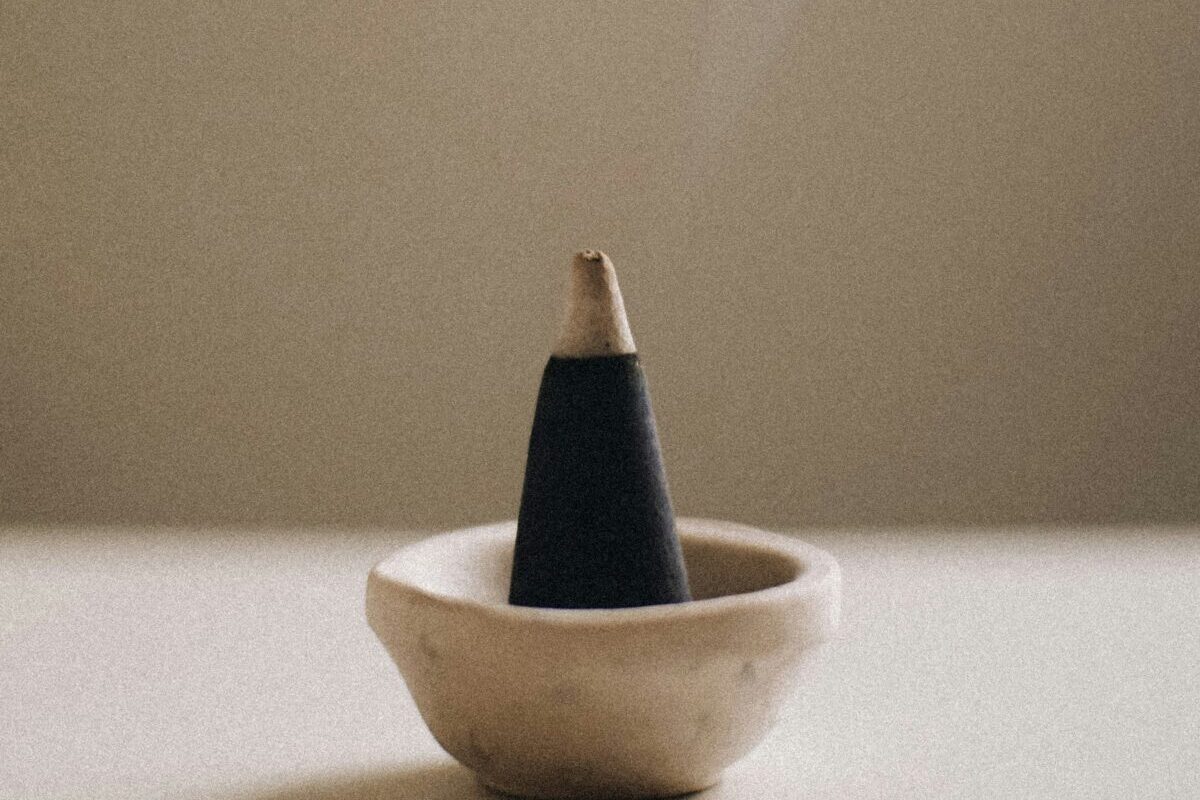

Cone incense is shaped like a tiny mountain. It burns more quickly than a stick, but produces more smoke and a stronger scent.
| Feature | Detail |
|---|---|
| Shape | Small cone (1–2 cm tall) |
| Burn time | 10–20 minutes |
| Fragrance | Rich, noticeable aroma |
| Use | Scenting a room quickly, short evening rituals |
Tip: Place the cone on a ceramic dish that can catch all the ash and won’t be damaged by heat.
③ Coil Incense (渦巻香 – Uzumaki-kō)
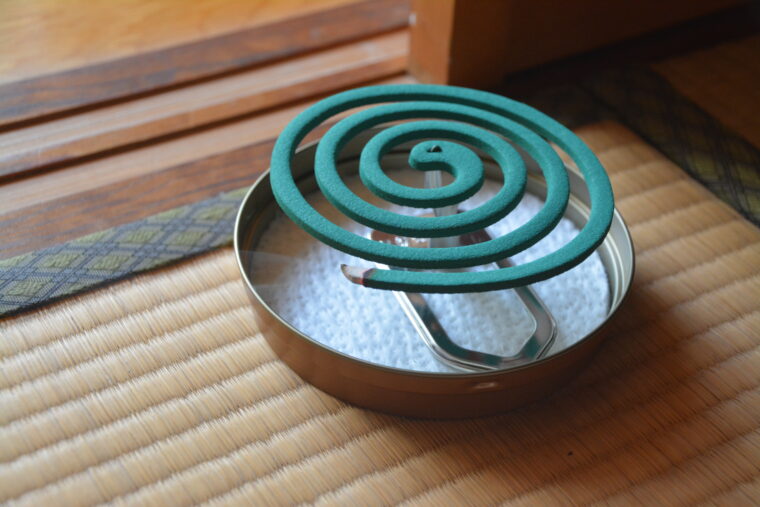

Coil incense looks like a spiral, like a mosquito coil. It’s usually hung or placed in a special burner and burns for a long time—sometimes several hours.
| Feature | Detail |
|---|---|
| Shape | Spiral/coil |
| Burn time | 1–3+ hours |
| Fragrance | Constant and soft |
| Use | Long meditations, summer evenings, temples |



In old-style temples or countryside homes, you’ll still see these coils hanging. They smell like summer in Japan.
④ Powder & Granule Incense (抹香・香料)
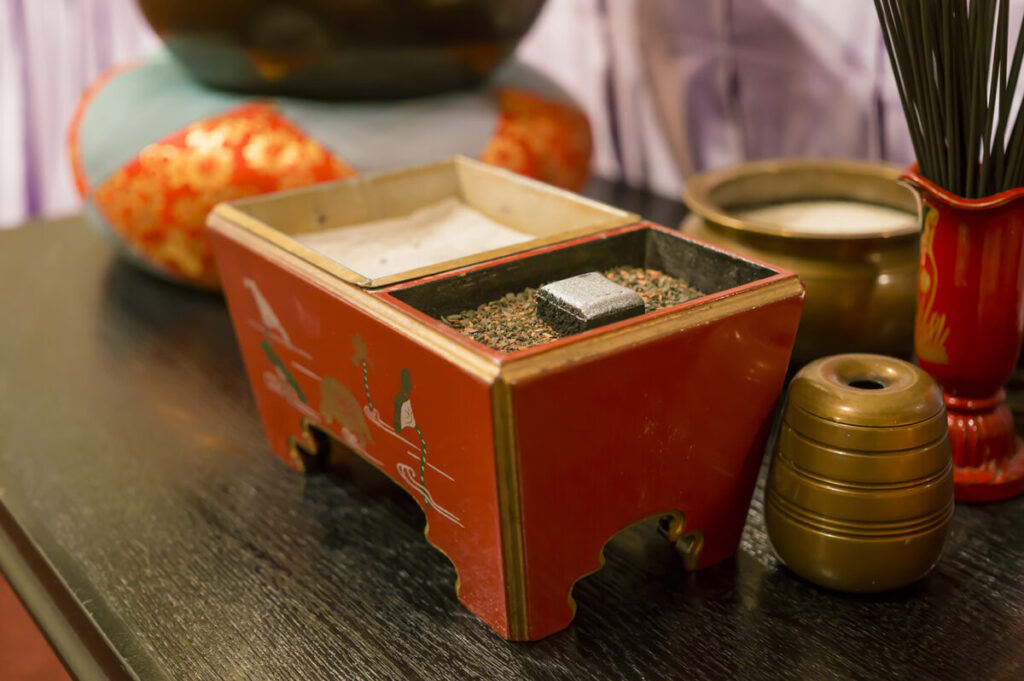

Used mainly in traditional ceremonies or with charcoal burners. You sprinkle a pinch onto a small charcoal block.
These types are often used in kōdō (the Way of Incense), a classical art form.
| Feature | Detail |
|---|---|
| Form | Loose powder or small resin grains |
| Burn method | Heated over charcoal |
| Fragrance | Refined, deep, layered |
| Use | Tea ceremony, temple rituals, incense appreciation events |
Note: This style requires more tools and care.
Not recommended for beginners—but fascinating once you dive in.
⑤ Smokeless Incense (空薫 – Soradaki)
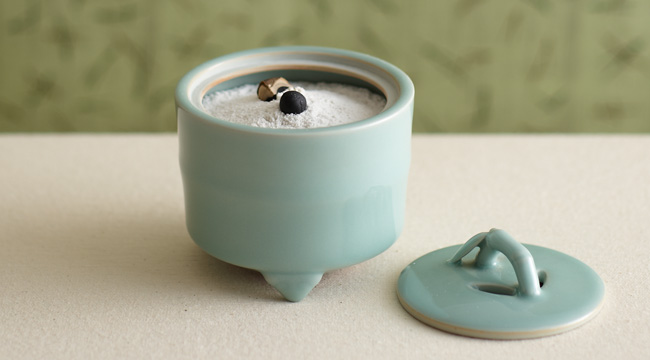

This modern method uses heat, not flame, to release the scent slowly without burning. There’s no smoke, no ash, and very little mess.
| Feature | Detail |
|---|---|
| Method | Gently warmed using ceramic or electric device |
| Use | Apartments, offices, scent-only enjoyment |
| Best for | People sensitive to smoke or living with pets/children |



On hot summer nights, I use smokeless incense—just scent, no heat. It’s peaceful in a different way.
Beginner-Friendly Starter Sets (Available on Amazon)
Asayu Japan Ceramic Holder Set – includes burner and stick samples
Summary Table: Incense Types at a Glance
| Type | Smoke | Burn Time | Best For |
|---|---|---|---|
| Stick | Light | 15–30 min | Everyday use, beginners |
| Cone | Medium | 10–20 min | Stronger scent, small rooms |
| Coil | Light | 1–3 hrs | Long sessions, temples |
| Powder/Granule | Varies | Varies | Ceremonies, kōdō |
| Smokeless | None | Slow-release | Apartments, modern settings |
3. How Japanese Incense Is Used in Daily Life
Not just temples and rituals—incense is part of quiet, modern living.
When many people think of incense, they imagine temples, ceremonies, or religious practices. And yes, incense has deep roots in Buddhism and Shinto in Japan.
But today, Japanese incense is also part of everyday life—used by people of all ages and backgrounds for many different reasons.
Let’s look at how incense is actually used in Japan, both traditionally and in modern homes.
1. Morning and Evening Rituals


Many Japanese people (especially older generations) light a stick of incense in the morning to welcome the day, and in the evening to relax.
It’s not about making the house smell strong—it’s about marking a moment with scent.
Like drinking tea or lighting a candle, it’s a way to shift your focus and reset your mood.



I burn one short stick while brewing my morning coffee. It’s how I know I’m not rushing—it’s just “me time.”
2. Meditation, Tea Ceremony, and Mindfulness
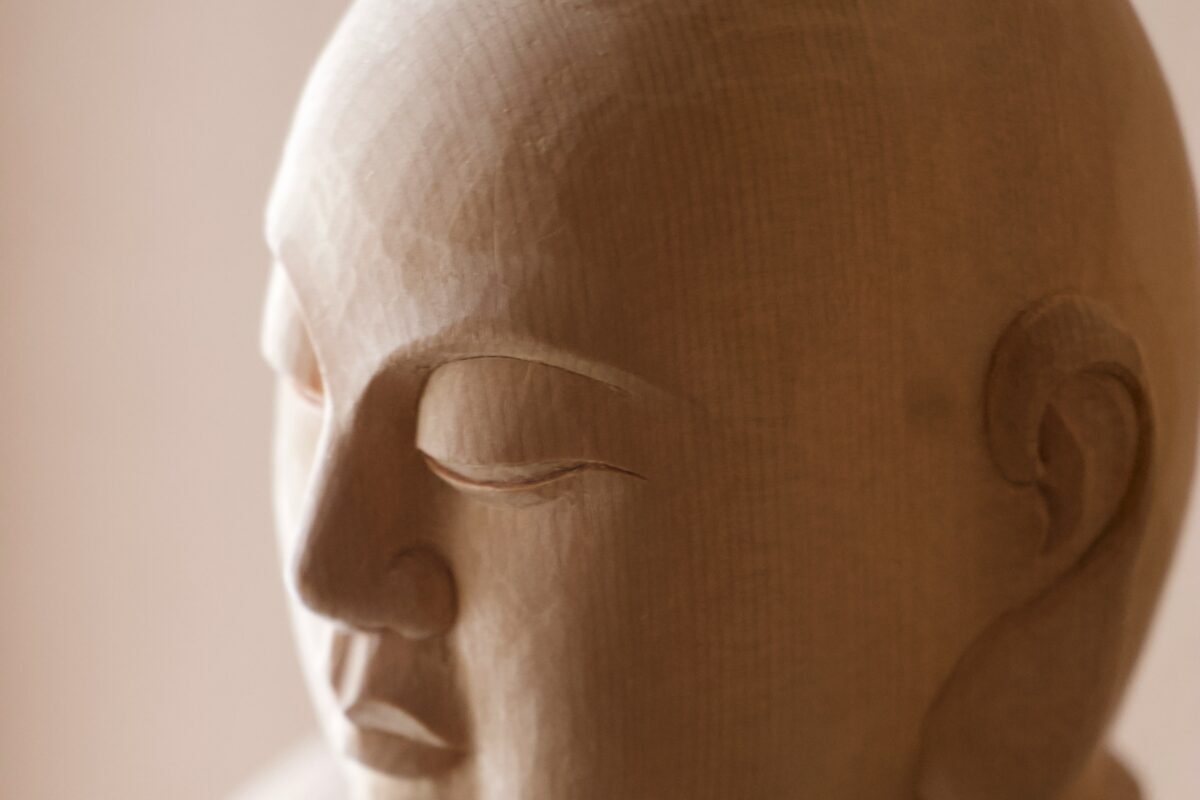

In Zen Buddhism and tea ceremony (茶道 – sadō), incense is used to prepare the mind and space.
The scent helps clear distractions, and signals that it’s time to be present.
Even outside of temples, many people use incense for meditation, yoga, or journaling at home.
Best types for this: subtle stick incense (like sandalwood or aloeswood)
3. Greeting Guests
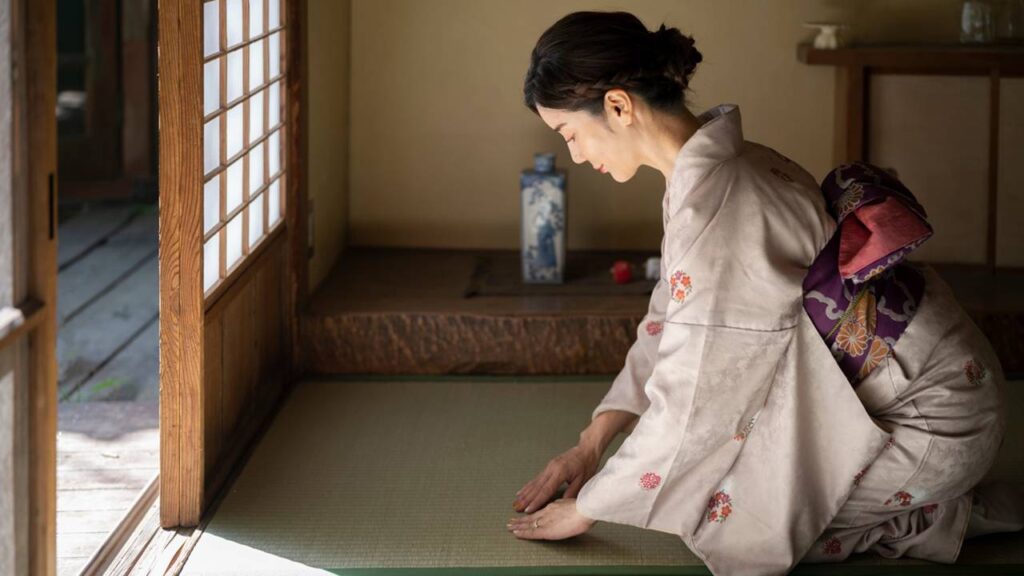

Burning incense before a guest arrives is a quiet way of saying:
“You’re welcome here.”
Unlike air fresheners, Japanese incense adds a warm, natural scent that fades softly over time.
This practice is especially common in traditional inns (ryokan), tea rooms, and older homes.
4. Honoring Ancestors
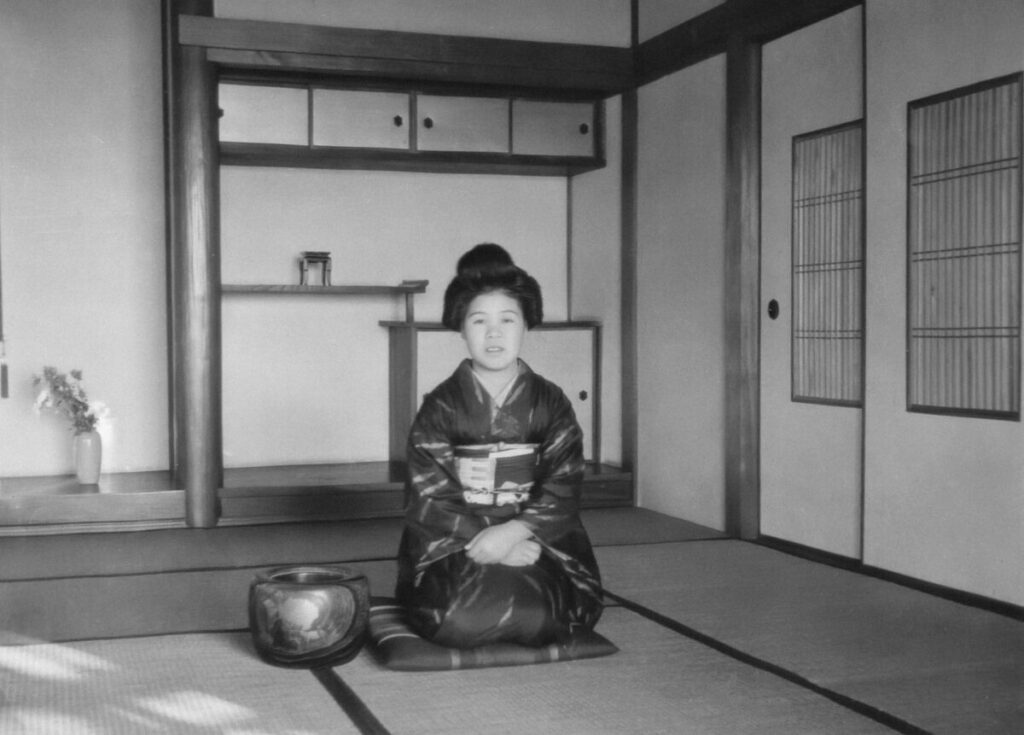

Yes, incense is still used in Buddhist altars (butsudan) to honor ancestors.
Families light incense during certain holidays (like Obon), memorial days, or simply as part of their morning routine.
Even in modern apartments, small altars are sometimes placed on a shelf, with incense and flowers.
Note: If you’re using incense purely for personal use, there’s no need to follow religious customs—but it’s good to understand the cultural background.
5. Creating a Mood or Scenting Spaces
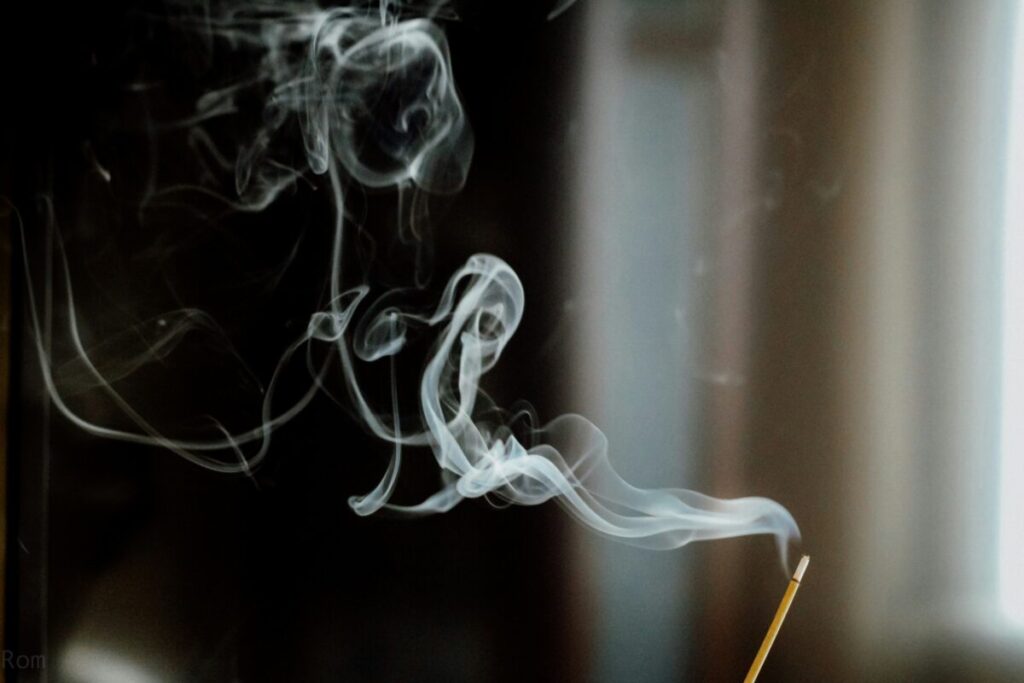

Incense can also be used like a candle or diffuser—to bring warmth to a room.
Depending on the scent, it can help you feel:
- Calm (sandalwood, cedar)
- Focused (cinnamon, clove)
- Nostalgic (cherry blossom, plum)
- Grounded (aloeswood, kyara)
Some people even place a burned stick near clothing or books to lightly scent them.



I sometimes burn incense before guests arrive—not to cover up smells, but to create a mood. It’s like setting the tone with music.
Summary: Incense in Modern Japan
| Use Case | Purpose | Common Type |
|---|---|---|
| Morning ritual | Set intention for the day | Stick incense |
| Meditation/Yoga | Enhance focus and awareness | Stick / Smokeless |
| Hosting guests | Create a welcoming space | Stick or cone |
| Ancestral tribute | Honor family, spiritual respect | Stick / granule |
| Daily ambiance | Relaxation or scent layering | Stick / cone |
4. Key Ingredients and Fragrances
Discover the natural scents behind Japanese incense.
Japanese incense is made from a rich blend of natural plant materials, herbs, spices, and resins. Unlike synthetic air fresheners or perfumes, the fragrance of Japanese incense comes from traditional ingredients that have been used for centuries.
Let’s explore some of the most important and iconic ones.
1. Sandalwood (Byakudan – 白檀)
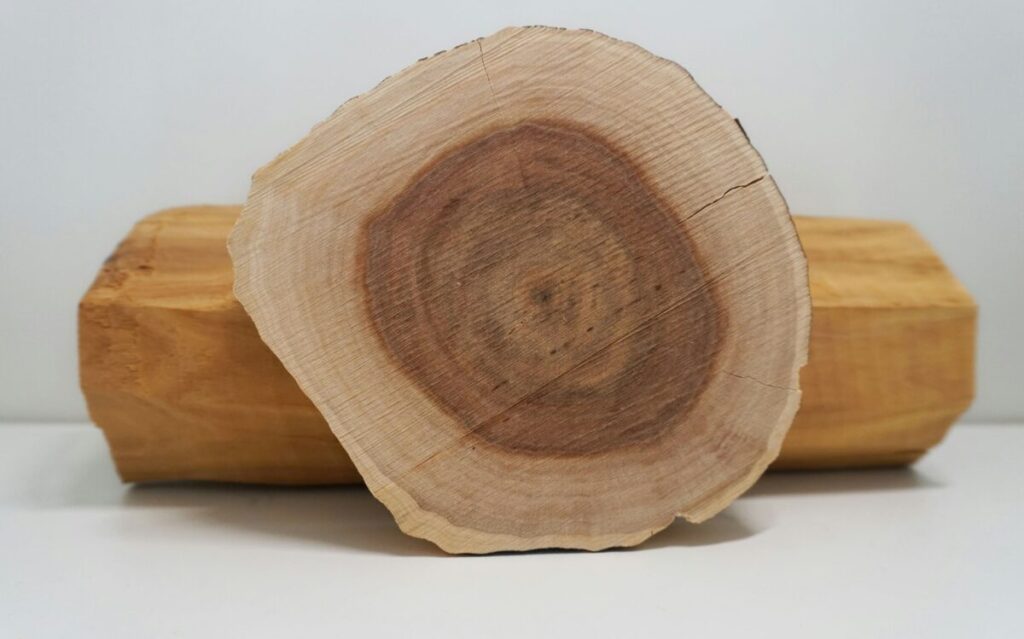

Sandalwood is one of the most common ingredients in Japanese incense. It has a warm, smooth, and slightly sweet scent that relaxes the mind.
- Origin: India or Indonesia
- Effect: Calming, grounding, good for meditation
- Popular with: Beginners and daily users



If you’re not sure where to start, go with sandalwood. It’s gentle, balanced, and almost everyone likes it.
Asayujapan(madeinJapan) is a great one to start with.
2. Aloeswood (Jinkō – 沈香)
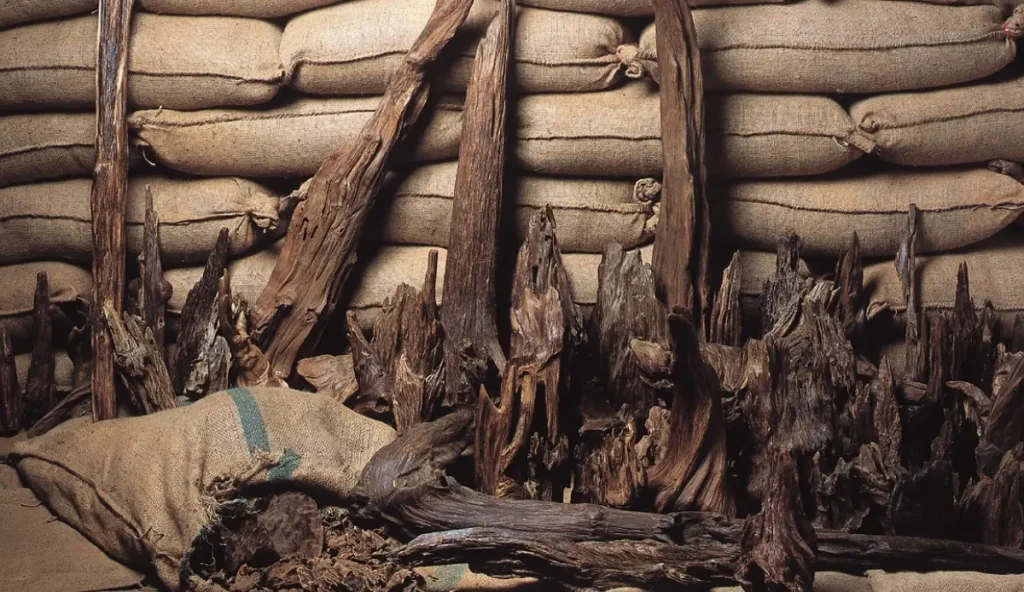

Aloeswood (also called agarwood) is rare and highly prized in Japan. It has a deep, rich, and slightly spicy scent that feels sacred and meditative.
- Origin: Southeast Asia
- Effect: Spiritual, complex, deeply relaxing
- Used in: Buddhist temples, kōdō (incense ceremony)
There are many grades of aloeswood—some are extremely expensive. The highest is called Kyara (伽羅), known for its elegant and mysterious aroma.
Asayujapan(madeinJapan) is a great one to start with.
3. Clove (Chōji – 丁子)
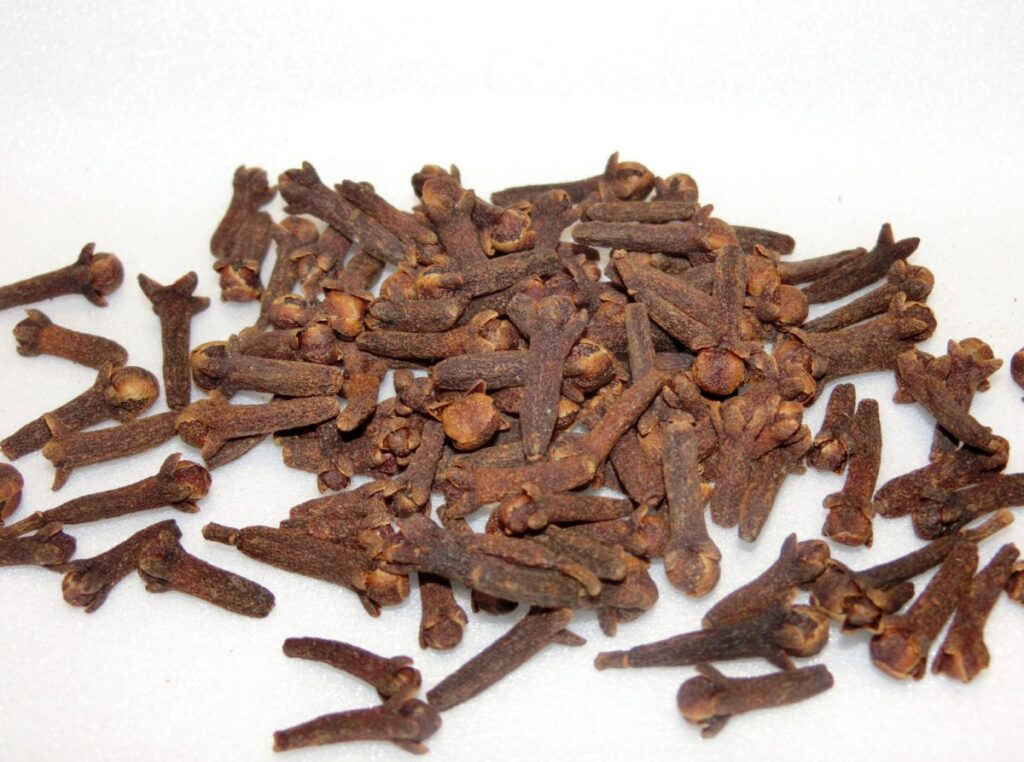

Clove is a spicy, slightly sweet aroma that adds warmth and sharpness to incense blends.
- Origin: Southeast Asia
- Effect: Warming, energizing, clears mental fog
- Often blended with: Cinnamon, sandalwood
4. Cinnamon Bark (Keihi – 桂皮)
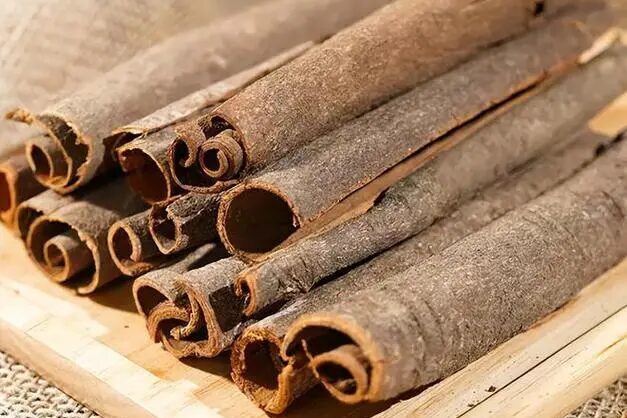

This gives incense a comforting, sweet-spicy scent that feels cozy and familiar.
- Effect: Stimulating, joyful
- Common in: Winter incense, blended sticks
5. Camphor (Shōnō – 樟脳)


Camphor is cool and sharp. It’s used in small amounts to freshen and purify.
- Effect: Refreshing, clearing
- Used for: Air purification, bug repellent (especially summer incense)
6. Resins (e.g., Benzoin, Frankincense, Myrrh)
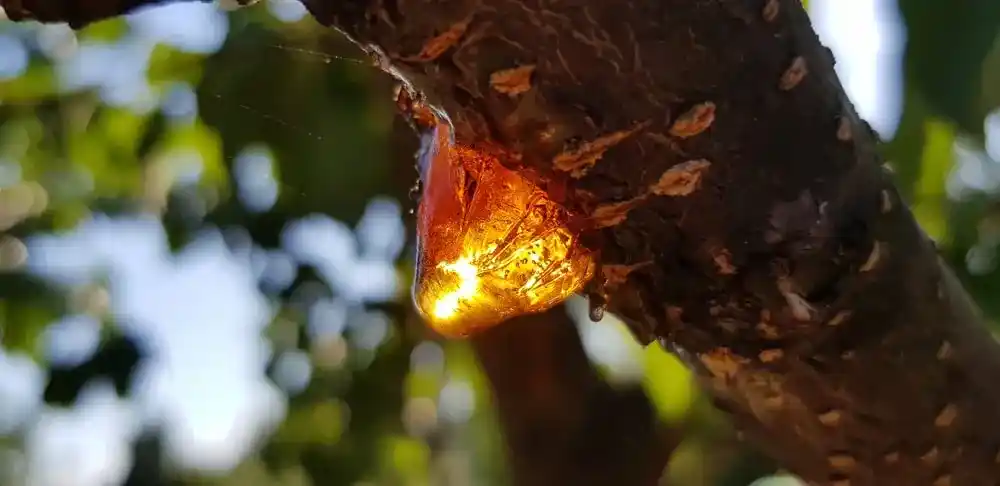

Japanese incense sometimes blends in western-style resins for a unique touch. These resins add a creamy, smooth, slightly vanilla or woody aroma.
- Used in: Modern blends, ceremonial incense
- Fun fact: These ingredients connect East and West through scent.
Summary Table: Common Fragrance Ingredients
| Ingredient | Japanese Name | Aroma Type | Effect |
|---|---|---|---|
| Sandalwood | 白檀 (Byakudan) | Warm, smooth | Calming, grounding |
| Aloeswood | 沈香 (Jinkō) | Rich, complex | Meditative, deep |
| Kyara | 伽羅 | Elegant, refined | Sacred, luxurious |
| Clove | 丁子 (Chōji) | Spicy, sweet | Energizing |
| Cinnamon Bark | 桂皮 (Keihi) | Sweet, warm | Comforting, happy |
| Camphor | 樟脳 (Shōnō) | Sharp, cooling | Refreshing, purifying |
| Frankincense | 乳香 (Nyūkō) | Resinous, sweet | Smooth, grounding |
How Scents Are Chosen in Japan
In Japan, people often choose incense based on:
- Time of day: Lighter scents in the morning, deeper ones at night
- Season: Cool fragrances in summer (like camphor), warm ones in winter (like cinnamon)
- Mood: Soft for relaxing, spicy for focus, deep for spiritual time



Don’t stress about picking the “right” scent. Start with one that feels calming—and let your nose guide you from there.
5. Famous Japanese Incense Brands
Know the names trusted by generations.
When you’re new to Japanese incense, all the beautiful packaging and poetic scent names can feel overwhelming. So where should you start?
Here are three of the most respected and widely available Japanese incense brands, known for their quality, history, and variety. Whether you’re buying in Japan or online, these names are safe, beginner-friendly choices.
1. Nippon Kodo (日本香堂)
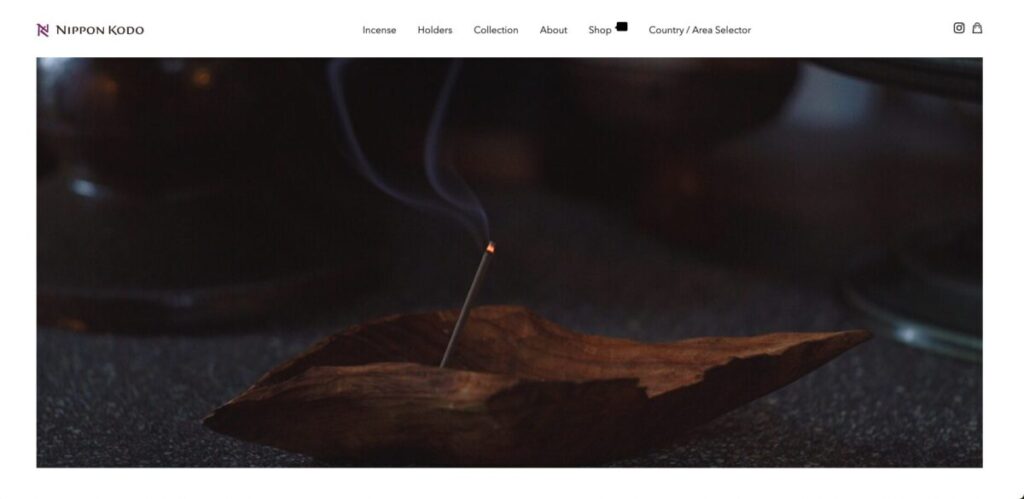

Founded: 1575 (roots), 1965 (as a company)
Headquarters: Tokyo
Nippon Kodo is Japan’s most famous incense maker. They produce a huge range—from everyday sticks to elegant gift sets and Buddhist offerings.
- Best for: Beginners, gift shoppers, spiritual users
- Popular lines: Kayuragi, Mainichi-koh, Oedo-Koh
- Price range: Affordable to premium
- Available on: Amazon (official store),Etsy, local stores



You can find Nippon Kodo everywhere in Japan—convenience stores, temples, department stores. That says a lot about trust.
You can try it on amazon—made-in-Japan classic.
2. Shoyeido (松栄堂)
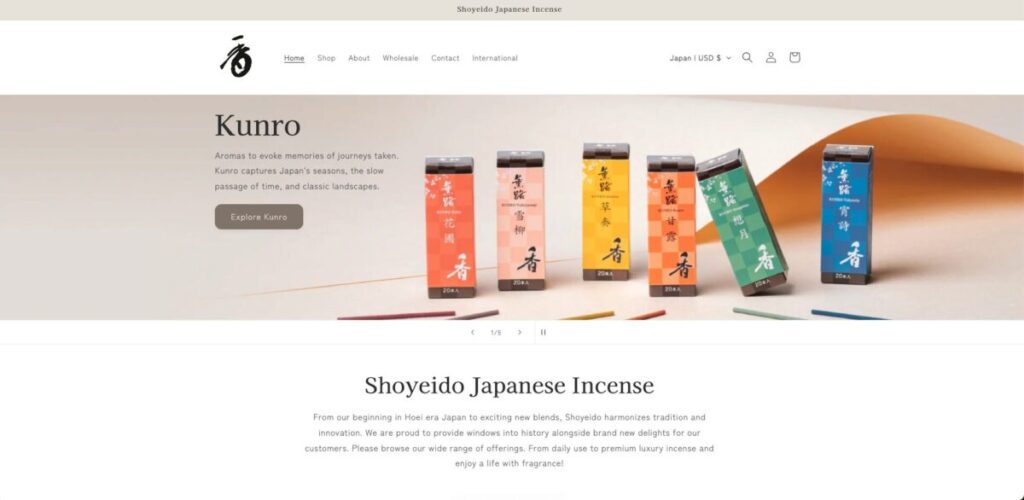

Founded: 1705
Headquarters: Kyoto
Shoyeido is known for its traditional recipes and natural ingredients, often using no synthetic oils at all. Their incense has a soft, complex fragrance that feels very “Kyoto”—refined, quiet, and deep.
- Best for: Meditation, cultural appreciation, incense purists
- Popular lines: Horin, Daily Incense, Premium Incense
- Price range: Mid to high-end
- Available on: Amazon (official store), Shoyeido USA, specialty shops



If you’ve ever stepped into a Kyoto temple and thought, “This scent feels sacred”—it was probably Shoyeido.
You can try it on amazon—made-in-Japan classic.
3. Asayu Japan(朝夕)
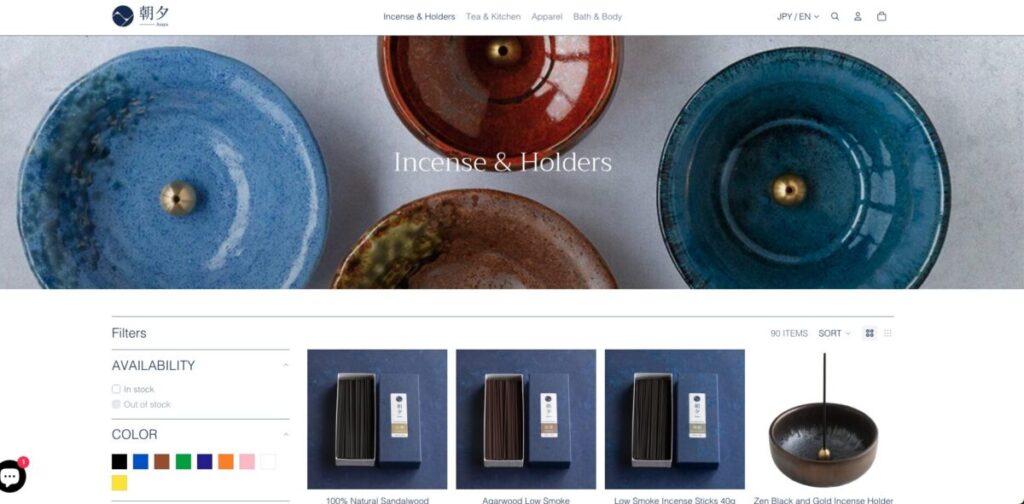

Headquarters: Japan (Kyoto-based aesthetics, international sales via Amazon)
Asayu Japan blends modern minimalism with traditional incense craftsmanship. Their products often combine low-smoke incense sticks with ceramic holders and brass stands, offering complete sets that are both beautiful and easy to use.
Their scents are subtle, calming, and designed for quiet daily rituals—perfect for anyone who wants a clean, Japanese incense experience without needing deep cultural knowledge.
- Best for: Beginners, design lovers, mindfulness routines
- Popular sets: Agarwood Gift Set, Ceramic Holder Collection
- Price range: Mid-range, gift-ready
- Available on: Amazon (official store)



Baieido’s incense feels more “ancient.” I wouldn’t use it for daily chores—it’s for quiet, serious moments.
You can try it on amazon—made-in-Japan classic.
Summary Table: Japanese Incense Brands at a Glance
| Brand | Founded | Best For | Signature Style |
|---|---|---|---|
| Nippon Kodo | 1575 | Beginners, gifts | Wide variety, floral & modern |
| Shoyeido | 1705 | Meditation, purists | Deep, traditional, all-natural |
| Baieido | 1657 | Spiritual depth | Aloeswood-focused, earthy tones |
These brands are trusted not only in Japan, but around the world. Each has its own philosophy, ingredients, and atmosphere—so feel free to explore.
In the next section, we’ll look at where to actually buy Japanese incense—especially if you live outside Japan.
6. Where to Buy Japanese Incense
Trusted shops, international shipping, and what to watch for
So—you’ve learned about Japanese incense, explored the types, and found a few favorite ingredients or brands.
Now comes the fun part: choosing your first incense to try.
Here’s where (and how) to buy authentic Japanese incense, especially if you live outside Japan.
1. Amazon.com (for international buyers)


Amazon is one of the easiest and fastest ways to get Japanese incense—especially for buyers in the US, UK, or Europe.
- Recommended brands: Nippon Kodo, Shoyeido, Asayu Japan
- Pros: Fast shipping, reliable customer reviews, return policies
- Tip: Always check that it says “Ships from Amazon” or “Ships internationally”



If you’re new, Amazon is the safest place to start. Look for products with photos, English descriptions, and reviews from real users.
2. Etsy (for artisan and gift-friendly options)


Etsy offers Japanese incense from small stores, collectors, and boutique sellers.
- Great for: Handmade incense holders, gift sets, rare scents
- Note: Some items may be Japan-made, others only Japan-style
Check the shop’s rating and country of origin to avoid imitation products.
3. Official Brand Stores
Some Japanese incense companies ship directly to international customers.
Bonus: Buying direct supports the makers and offers access to rare items.
4. Japan-based Forwarding Services (Advanced users only)
If you want a specific item that’s only available on Amazon.co.jp or a Japanese site, consider a forwarding service like:
- Buyee.jp
- White Rabbit Express
- Tenso.com
They let you purchase in Japan and ship overseas—but be aware of higher costs, longer wait times, and sometimes limited English support.
What to Look For When Buying
| Look for… | Avoid… |
|---|---|
| “Made in Japan” label | Vague origin (e.g., “Asian-style”) |
| Reviews from real customers | No reviews or unclear descriptions |
| Brands like Nippon Kodo or Shoyeido | Cheap multi-pack generics |
| Clear scent description | Products with only “fragrance” |
Best For Beginners
If you’re just starting out and want to try a little of everything:
- “Kayuragi” line by Nippon Kodo– floral, fruit, and wood scents
- “Horin” series by Shoyeido – elegant, calm, perfect for evenings
- Asayu Japan sets – beginner-friendly holders + sticks
These are all available on Amazon with worldwide shipping.
7. Cultural Notes and Proper Use
Respecting the traditions, without overcomplicating things.
Japanese incense carries centuries of tradition. While you absolutely don’t need to be religious or Japanese to enjoy it, it helps to understand a few key points—especially if you’re giving it as a gift, using it in a shared space, or blending it into daily life.
Here are some cultural notes and gentle etiquette tips.
1. Not all incense is religious.
Yes, incense is used in Buddhist rituals and at ancestral altars (butsudan), especially to show respect for the dead.
But that doesn’t mean every incense stick is sacred.
- Daily-use incense: for relaxation, scenting the room, mindfulness
- Religious incense: often used with specific gestures, like bowing or praying
- How to tell: Packaging or branding will often indicate if it’s for spiritual use



I burn incense while journaling or cooking dinner. It’s not a ceremony—it’s a rhythm.
2. Use a proper holder—never just a plate or cup.
Incense burns hot, and ash can scatter. Always use a ceramic, stone, or metal holder.
Some types (like powder incense) even require charcoal and ash layers for safety.
3. Don’t blow out the flame.
If your incense catches fire briefly while lighting, gently wave your hand or fan it out.
In Japanese tradition, blowing with your mouth is sometimes seen as rude—especially in spiritual contexts.
4. Don’t burn incense during meals.
While incense can help set the mood before or after eating, it’s generally avoided during meals, as it may interfere with the enjoyment of food.
5. Don’t assume all scents are neutral.
Some incense (especially aloeswood or kyara) can evoke very strong emotional or spiritual associations for Japanese people—especially older generations.
- If you’re burning incense in a shared or public space (like an office), choose light, clean scents like sandalwood or green tea.
- If gifting incense, avoid overly smoky or “temple-like” varieties unless you’re sure it will be appreciated.
6. Japanese incense ≠ Indian or Tibetan incense
This may sound obvious, but many people unfamiliar with incense think they’re all the same.
Japanese incense is generally:
| Japanese incense | Indian/Tibetan incense |
|---|---|
| Soft, subtle scent | Bold, sometimes intense scent |
| No bamboo stick | Often has a wooden core |
| Low smoke | Medium to heavy smoke |
| Short burn time | Often burns longer |
Final Reminder
You don’t have to “do it right” to enjoy incense.
But learning just a little about the culture behind it helps you appreciate it even more—and shows respect to the tradition.
9. Final Thoughts and Next Steps
One quiet stick. That’s all it takes.
Japanese incense isn’t loud.
It doesn’t fill the room with smoke or demand attention.
It simply marks a moment—quietly, gently, meaningfully.
Whether you’re starting your day, ending it, focusing your mind, or welcoming a guest, incense can be more than a scent. It can become a small but powerful ritual.
You don’t need to understand everything at once. You don’t need to buy the “perfect” fragrance or holder.
Just start with one stick.
Breathe.
That’s enough.
What You Can Do Next
- Try a beginner-friendly incense set from a trusted brand like Nippon Kodo or Shoyeido
- Give it as a gift to someone who needs a moment of calm
And if you’re already burning incense—welcome.
You’re part of a quiet tradition that spans over 1,000 years.



I’ve burned incense nearly every day for the last 15 years. Not for religion or habit—just for space, and breath. You’ll find your own rhythm too.
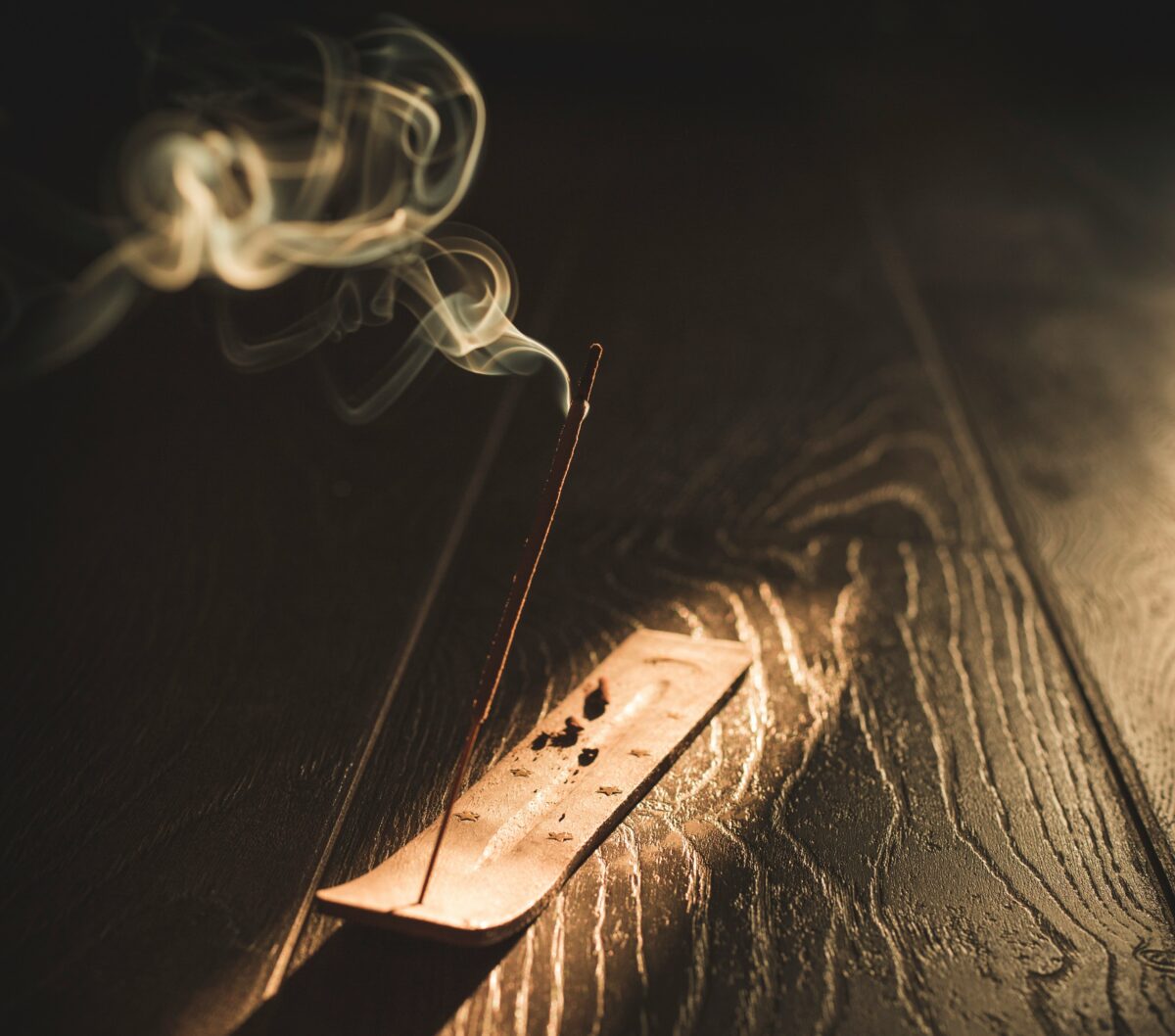
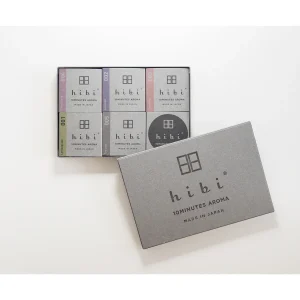
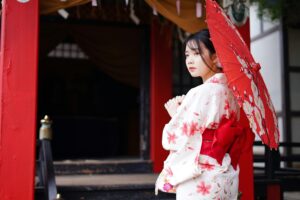


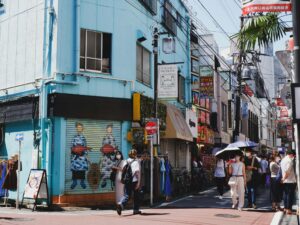


Comments